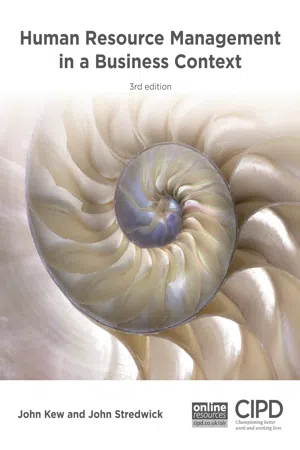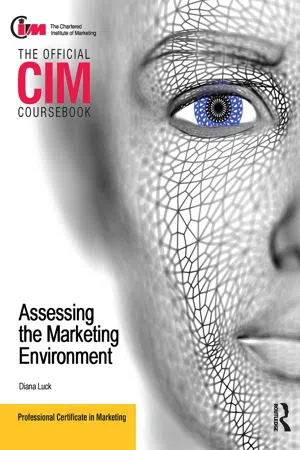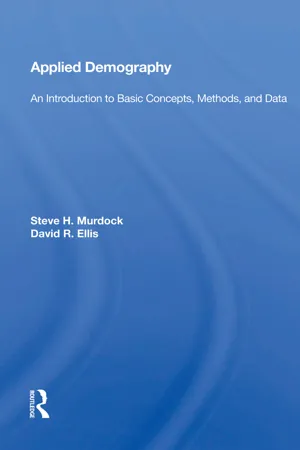Social Sciences
Demographic Trends UK
Demographic trends in the UK refer to the statistical changes in the population over time. This includes factors such as birth rates, death rates, immigration, and aging. Understanding these trends is important for policymakers, businesses, and organizations to plan for future needs in areas such as healthcare, education, and workforce development.
Written by Perlego with AI-assistance
Related key terms
8 Key excerpts on "Demographic Trends UK"
- eBook - ePub
- John Kew, John Stredwick(Authors)
- 2016(Publication Date)
- CIPD - Kogan Page(Publisher)
CHAPTER 7
Demographic and Social Trends
LEARNING OUTCOMES
When you have completed this chapter you should be able to understand, explain and critically evaluate:- the key demographic statistics in a local, national, European and international setting
- the important effects produced by changes in demographic influences, especially those produced by world-wide migration
- how demography has major influences on businesses and government, who need to respond in a positive way
- the appropriateness of responses by businesses and government to take advantage of major demographic changes
- the major theories of social stratification and their application to the UK setting
- the nature and extent of social mobility in the UK
- the reasons for the slowing rate of social mobility in the UK and its effects
- the extent and nature of inequality and poverty in the UK
- the similarities and differences between equal opportunities and diversity.
7.1 DEMOGRAPHY
7.1.1 INTRODUCTION
Demography looks at populations – their sizes, characteristics and the way they change. It sounds like a dry and academic subject, but that is far from the truth. Population changes throughout the ages have been one of the major determining factors in economic development, political activity and social change. A growth in population can lead to a number of consequences. It can lead to wars, such as when the Roman Empire constantly fought with the barbarians in the search to extend its boundaries to secure more extensive food supplies for its growing population, or the sweeping hordes out of Mongolia and the Far East a few centuries later. It can also lead to extensive economic growth. It was only possible for the industrial revolution to get under way in the UK factories in the late eighteenth century with the growing supply of surplus labour from the countryside, following the enclosure movement and technological agricultural developments. China’s rapid growth and industrialisation from the 1980s occurred for the same reason. - eBook - ePub
- Keith Porter, Paul Smith, Roger Fagg(Authors)
- 2007(Publication Date)
- Routledge(Publisher)
Demographic and social trends
DOI: 10.4324/9780080492810-13Chapter objectives
In this chapter you will:- Evaluate the impact of demographic trends for markets for goods and services and for the labour market
- Consider the implications of demographic trends for government
- Review major social trends
- Consider changing social attitudes and the evolving social structure
- Assess the role played by organizations in shaping social tends and attitudes.
Chapter introduction
In this chapter we review a range of external environmental factors associated with social and cultural change. The issues and developments highlighted have major implications for corporate strategy. We begin by discussing the crucial importance of demographic change and continue with an assessment of the debate concerning social class. We then examine how changing attitudes impact on organizations.Case study
Table 13.1 PopulationUK population grows to 59.6 million
In 2003 the UK was home to 59.5 million people. This was an 18 per cent increase from 50.3 million in 1951, and a 3.2 per cent increase over the last decade (1993 to 2003). Until the mid-1990s, this growth was mainly due to natural increase as the number of births exceeded the number of deaths. Since the late 1990s, there has still been natural increase but net international migration into the UK from abroad has been an increasingly important factor in population growth (see Figure 13.1 ).Figure 13.1 Natural increase and net migration as components of population change, UK.In 2003, 84 per cent of the UK population were living in England, 8 per cent in Scotland, 5 per cent in Wales and 3 per cent in Northern Ireland (Table 13.1 - Diana Luck(Author)
- 2010(Publication Date)
- Routledge(Publisher)
It is important for marketers to appreciate the composition of a given population. Use the Internet or your library to prepare a brief revision on the following:Examples of trends uncovered by censuses considered to be significant to marketers are:Total population, current and trend rate of change of the UK population.Age, gender, marital status and location of population.Occupational structure and ethnic mix.Significant trends in structure (e.g. ageing, urbanisation).You may find it helpful to browse through the charts and tables in Social Trends or its local equivalent.Current population levels and the future size of any given population.The growth rates of developed countries versus developing countries.The age and gender structure and its distribution by region/locality.Migration within national borders and between international borders.The demographic impact on world resources and the physical environment.INSIGHT
Russia is facing a demographic and societal crisis because its population of 149 million is currently being seen to shrink by nearly three-quarters of a million a year. The UN has even warned that its population level might fall to under 100 million by 2050. This is expected to cause dramatic impacts on its economy and security. The economy is booming due to high oil, gas and commodity prices. However, the benefits have not been reaped by the bulk of the population. Net outward migration is also rising.- eBook - ePub
The Social Context of Ageing
A Textbook of Gerontology
- Christina Victor(Author)
- 2004(Publication Date)
- Routledge(Publisher)
Much of the stimulus for the development of social gerontology as an academic discipline, and as an area of social and political concern, has come from the increase in the number and proportion of the population categorised as 'old' or 'elderly'. Indeed issues concerned with the demography of ageing are central in understanding many of the social, political and policy-related issues characteristic of twenty-firstcentury Britain. The backdrop for much political and policy-related debate is the concern about 'the demographic time bomb'. This is a rather pejorative term for the changing age composition of our population and of the balance between different age groups. As this chapter demonstrates, over the past 150 years there has been a profound change in the age composition of the British population with the 'ageing' of the population and a decrease in the number of children. This is represented in some quarters as an impending social disaster for two reasons. First, 'ageing' populations are attributed many of the negative stereotypes given to ageing at an individual level. All the negative attributes ascribed to an individual older person have been transferred to ageing populations. These are characterised as lack of energy, enthusiasm, innovation and artistic and intellectual achievement. Ageing populations are seen as being unresponsive to change and traditional in approach. Second, the increase in the number of older people is seen as having negative, perhaps even dire, consequences for the social and health services. These arguments taken together have been used to describe what Jefferys (1983) termed the 'moral panic' of population ageing which focus upon the perceived 'burden' which the increased numbers of older people will impose upon the state and younger people. Another way of describing this negative perspective is apocalyptic demography (Vincent, 1999) — the perception that we will be overwhelmed in social, political and welfare terms by the increasing numbers of old people.In this chapter we examine the demographic trends which have brought about the growth in the number of older people in society by considering how populations 'age' and examining ways of measuring 'population ageing'. We then describe the demographic characteristics of the older section of the population and consider how the characteristics of this segment of society may change in future decades. The majority of the data presented relate to the United Kingdom, but many of the points raised have a wider resonance and parallels may be drawn with many countries in Europe, the Americas and Australasia. Hence the changing of the age profile of the population towards an increase in the number and proportion of older people is not unique to the United Kingdom but has a much wider resonance.The ageing of populations
Demography is concerned with describing, analysing and understanding trends in the structure of populations. In this context populations are usually defined in terms of nation-states as these are the units for which data are collected, but demographic analysis may be undertaken with various subsets of national populations such as regions, counties or specially constituted populations such as inner cities (or rural areas). The structure of a given population is rarely static as the relationship between the key drivers of demographic change; birth rates, death rates and migration are highly fluid and subject to considerable variation over time. It is the interaction between these three sets of factors that brings about demographic change. In the case of the United Kingdom, population ageing has largely come about because of changes in birth and death rates. - eBook - ePub
- Tony Champion, Jane Falkingham(Authors)
- 2016(Publication Date)
- Rowman & Littlefield International(Publisher)
Over the next twenty-five years, we can say with a fair degree of certainty that the population will get larger, the population will get older and the population will become more diverse in terms of both ethnic composition and family forms. What is less clear is exactly how these changes will impact on particular places and alter their socio-demographic profiles, including whether urban-to-rural migration will pick up further as economic conditions improve, whether the dispersal of ethnic minority groups will accelerate and whether social segregation will intensify, all these being partly related to what long-term solution, if any, is found for the current ‘housing crisis’. The need to plan for this changing population remains as critical today as it did twenty-five years ago; so, too, does the need for better intelligence on how the UK’s population is altering over time, on what are the principal drivers of these changes and on what policy levers are likely to be more effective in encouraging the more welcome trends and counteracting the less desirable developments.The remaining chapters of this book aim to move forward our understanding of the UK’s changing demography and the opportunities and challenges that arise from this, building on the overview provided in the previous sections. The next two chapters focus on the ageing population, for which the trends appear highly predictable, though this does not diminish the scale of the implications for health and social care (Chapter 2 ), nor the challenge of ensuring well-being in the later stages of the life course for the many and not just the privileged few (Chapter 3 ). Attention then turns to the topic of immigration, which is sometimes seen as part of the solution to population ageing but which has much more uncertainty attached to it, in terms of both the numbers and the types of people that can be expected to arrive in any year and as regards their impacts on the economy and social relations (Chapter 4 ), but it seems that at least in one important respect, that of fertility and family size, there is evidence of convergence towards the national mean by the non-UK born and their descendants (Chapter 5 ).Chapters 6 and 7 focus on aspects relating to families and households, with the former taking a children’s perspective on the profound changes that have taken place in the structure of British families over recent decades and emphasising the wide diversity of conditions under which children grow up. These are reflected in similarly important changes in household composition and in the increasing difficulty that adults are facing in satisfying their housing needs and aspirations, with the cessation of the century-long decline in average household size, which seems at least partly due to shortages on the supply side (Chapter 7 ). The historically low levels of housebuilding in recent years can help to explain the reduction in frequency of moving home by almost all types of people apart from those of university age, including the fading of net north-to-south migration since the 1980s and the slowdown in the urban exodus since the early 2000s, with potential implications for the efficiency of housing and labour markets that merit further study (Chapter 8 ). For ethnic minorities, however, an accelerating dispersal from the original locales of immigrant settlement is a key change, though the main message of Chapter 9 - eBook - ePub
Applied Demography
An Introduction To Basic Concepts, Methods, And Data
- Steve H. Murdock(Author)
- 2019(Publication Date)
- Routledge(Publisher)
2 Demographic Concepts and Trends: The Conceptual Base and Recent Patterns of Demographic ChangeThe discussion in this chapter is intended to define the major concepts and variables used in applied demography and to provide information that will allow the reader to obtain an initial base of demographic knowledge regarding current patterns for the measures of these concepts and variables. It must be recognized, however, that no single chapter, or any single work, can replace the need for continuous study to obtain and maintain knowledge of demographic change.Defining Key Concepts and Terms
In this section, we examine some of the key concepts and terms used in demography and demographic analyses. It is essential for those using demographic data to be aware of the underlying definitions and dimensions of demography's key concepts. We delineate these concepts briefly below indicating both how they are defined and the major differentials or variations in them among different demographic groups and relative to other demographic, social, and economic factors.Population
Perhaps the most basic of all terms in demography is that of population. A population consists of the persons living in a specific geographical area at a specific point in time (see Ryder, 1964 for a useful description of the concept of population). Two aspects of the concept of population as used in demography are important to emphasize.First, the term population tends to be used to refer to aggregate characteristics of a population living in an area; that is, to characteristics that are descriptive of the population but not necessarily of any given individual within the population. For example, a population's death rate is not reducible to the individuals within the population. That is, any given person in an area is either alive or dead at a given point in time; he or she has no death rate. On the other hand, a population's death rate is the aggregate effect of all deaths in the population. A death rate is thus uniquely an aggregate rather than an individualistic measure. - eBook - ePub
- Clifton D. Bryant, Dennis L. Peck(Authors)
- 2006(Publication Date)
- SAGE Publications, Inc(Publisher)
To illustrate, a formal demographer might examine among populations the influence of age composition on the birth rate or, alternately, the influence of the birth rate on age composition. Another illustration of a formal demographic exercise would be an analysis among cities of the effects of the sex composition of in-migrants on city death rates. In contrast, a social demographer might study the influence of a sociological independent variable, such as social class, on the death rate; or the effects of a social psychological variable, such as attitudes about motherhood, on desired and intended fertility; or the effects of a geographic variable, such as annual rainfall, on population density; or the influence of an economic variable, such as economic or livelihood opportunities, on the migration rate (Kammeyer and Ginn 1986). Social demography is necessarily broader in scope and orientation than formal demography. As Preston (1993) has written, it includes “research of any disciplinary stripe on the causes and consequences of population change” (p. 593).Schofield and Coleman (1986) have brought these two approaches together, as follows:The subject matter of demography may be imagined as being arranged within a sphere with a hard mathematical core and a softer socio-economic and biological rind. The core represents the specific technical property of demography; the mathematical theory which deals with statics and dynamics of population; vital rates in relation to the age structure, dynamics, growth and their perturbations, and all the techniques of measurement, analysis and substitution that follow. . . . But this hard core of demography does not touch the surface of the real world directly, except through measurement and reconstruction. It does so only when the population is made specific. An outer structure of theory and fact is then necessary to explain and predict that population’s response, through the specific agencies of independent biological, social and economic causes and consequences of population trends. In this outer region of demography, the numerical techniques and ideas of demography act as an interdisciplinary common currency. Demography, which deals with the hardest (biological) facts in social science, enables material from one subject to be used in conjunction with material drawn from another. This permits the risks of the fundamental human events of birth and death to be analyzed interchangeably by ideas which may draw on sociology, geography, history, biology and other subjects. (P. 5)Demographers, however, do not always agree about the boundaries and restrictions of their field. Caldwell (1996) states the problem succinctly as follows: - eBook - ePub
- Peter Catterall, James Obelkevich(Authors)
- 2002(Publication Date)
- Routledge(Publisher)
Chapter 2Elements of demographic change in Britain since 1945
Richard M.Smith
One theory, above all others, has provided a framework for much of the discussion of the striking demographic changes that have occurred in the last century. This is the so-called ‘Demographic Transition Theory’ and there has been considerable debate concerning whether post-war British society, indeed Western society as a whole, continues to be interpretable within terms of that theory’s key premises (Davis et al. 1987). In its essentials, Demographic Transition Theory is a type of dogma of the ‘irreversible sequential change’ variety. It is an evolutionary schema setting out the demographic stages through which societies are bound to move as a consequence of industrialisation and urbanisation (Woods 1982:158-84). The initial condition in which high mortality and high fertility coexisted is stage I, and some have suggested in the English case that this ended c. 1750. This was followed by a phase of falling mortality in association with high fertility, creating rapid demographic growth (Stage II) until c. 1870; and after this there was a compensatory fall in fertility in Stage III which culminated when stationary demographic conditions were established in which very low mortality and fertility coincided simultaneously, especially after c. 1966. Much empirical research has shown that this model provides a problematic basis for our understanding of British demographic history in the period prior to 1900. Stage I in England cannot accurately be described as one in which high fertility and mortality coexisted in a compensatory fashion; nor can the great surge of population growth after 1750 be accurately explained by a fall in mortality (Wrigley and Schofield 1981). Nineteenth-century changes do not seem readily depicted as fertility falls occurring in the wake of prior mortality declines (Woods 1992). These matters cannot be the subject of discussion in this chapter as our purpose is to assess whether the last forty or forty- five years can be seen as the culmination of this stadial model. Do they represent the triumphant establishment of Stage III or should this Whiggish device be jettisoned and replaced by an attempt to conceptualise a post- transitional demographic regime of low birth rates (of the kind associated with below replacement rate fertility), low mortality, population ageing, stationary or negative demographic growth? The figures relating to total population numbers in the United Kingdom seem, at least superficially, to be consistent with such a view. Contrary to the predictions of Transition Theory, population grew quite rapidly in the decades immediately following the Second World War. The United Kingdom contained 50.3 million people in 1951 (compared with 46 million in 1931) and growth thereafter took that figure to almost 56 million in 1971. The last two decades, however, have witnessed much slower demographic expansion and the population estimated for 1991 is only c.
Learn about this page
Index pages curate the most relevant extracts from our library of academic textbooks. They’ve been created using an in-house natural language model (NLM), each adding context and meaning to key research topics.







